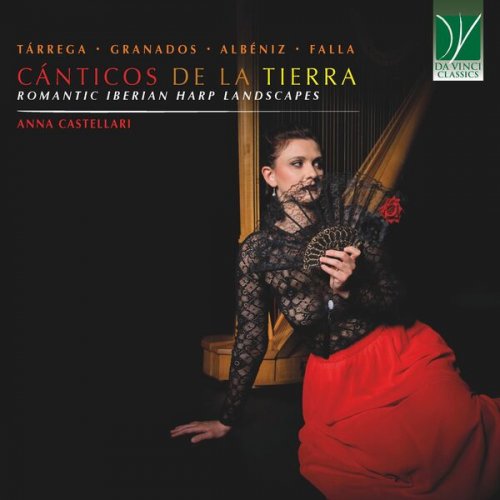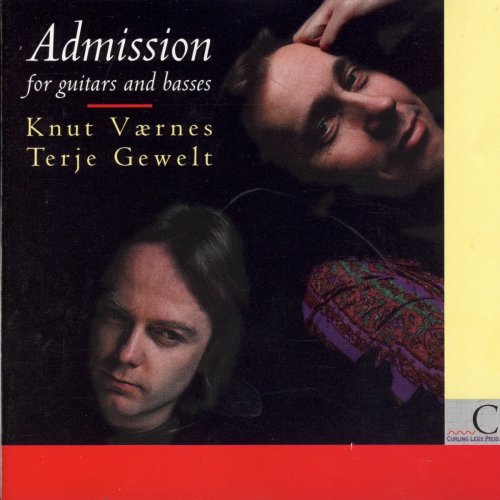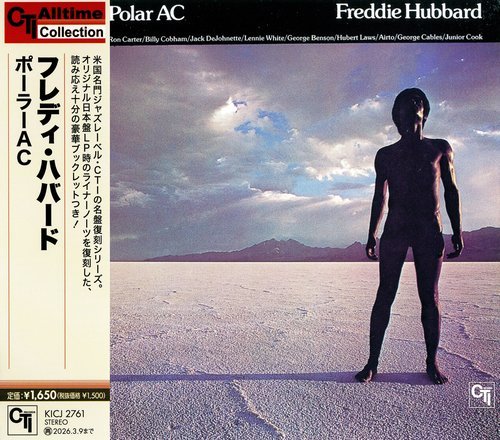Anna Castellari - Cánticos de la Tierra: Romantic Iberian Harp Landscapes (2025)

Artist: Anna Castellari
Title: Cánticos de la Tierra: Romantic Iberian Harp Landscapes
Year Of Release: 2025
Label: Da Vinci Classics
Genre: Classical Harp
Quality: flac lossless (tracks)
Total Time: 01:08:29
Total Size: 230 mb
WebSite: Album Preview
TracklistTitle: Cánticos de la Tierra: Romantic Iberian Harp Landscapes
Year Of Release: 2025
Label: Da Vinci Classics
Genre: Classical Harp
Quality: flac lossless (tracks)
Total Time: 01:08:29
Total Size: 230 mb
WebSite: Album Preview
01. Recuerdos de la Alhambra
02. Danza Española: No. 5, Andaluza - La Playera
03. España, Op. 165: No. 3, Malagueña
04. Suite Española No.1, Op. 47: No. 1 in F Major, Granada
05. Suite Española No. 1, Op. 47: No. 5 in G Minor, Asturias - Leyenda
06. Cantos de España, Op. 232: No. 4, Córdoba
07. Recuerdos de viaje, Op. 71: No. 6, Rumores de la caleta - Malagueña
08. Suite Española No. 2, Op. 97: No. 1, Zaragoza - Capricho
09. Mallorca - Barcarola, Op. 202
10. 12 Piezas Características, Op. 92: No. 12, Torre Bermeja - Serenata
11. Serenata Andaluza
12. Spanish Dance No. 1
The modern journey of the harp into the concert hall has been shaped as much by acts of transcription as by original inspiration. From the nineteenth century onwards, harpists often relied on transcriptions, drawing on the abundance of operatic fantasies and salon compositions to showcase the possibilities of their instrument. Yet in the twentieth century a more deliberate effort emerged, in which transcribing was not only practical but also an artistic statement. Among the leading figures of this movement was Nicanor Zabaleta, whose career redefined the harp role in the modern repertoire. By adapting Spanish piano and guitar works into idiomatic harp versions, and by persuading composers to create new scores directly for the instrument, Zabaleta demonstrated that the harp could be both a faithful translator of national idioms and a generator of original voices. His advocacy brought about works such as Joaquín Rodrigo’s Concierto serenata, dedicated to him, which revealed the harp capacity for brilliance and rhythmic vitality in a distinctly Iberian idiom. Zabaleta also prepared his own editions of Albéniz and Granados for harp and programmed them alongside newly composed works, effectively curating a canon that combined transcription with modern creation. This duality has remained a defining feature of the harp in Spain: it is both a prism through which national music is refracted and a fertile ground for new idioms.
Spanish composers themselves did not ignore the instrument. Among many others Gerardo Gombau Guerra, who wrote Apunte Betico to describe the Betica region, today’s Andalucia; Joaquín Rodrigo, who returned to the instrument in works such as his Sones en la Giralda, the famous Sevillian cathedral belfry; Jesus Guridi, whose Viejo zortzico is based on a Basque dance in 5/8. These original contributions expanded the harp vocabulary, but they were always in dialogue with the more numerous transcriptions of Spanish piano and guitar repertoire that had already proven the affinity of the harp for the idiom. The coexistence of original works and transcriptions reveals the special place of the harp in Spanish music. While it was never a folkloric instrument in the sense of the guitar, its sonority seemed destined to capture the shimmer of Andalusian nights, the tremble of Moorish ornament, and the sparkle of dance rhythms that define the Spanish nationalist imagination.
Within this cultural frame, the programme at hand can be heard as a journey through Spanish landscapes of memory. Francisco Tárrega’s Recuerdos de la Alhambra, composed in 1899 and dedicated in the manuscript to his pupil Conchita G. de Jacoby, epitomizes the guitar’s capacity to suggest endless song through the device of tremolo. On the harp the figure becomes more than imitation: it is a single line stretched into an unbroken thread of resonance, sustained by the natural capacity of the instrument to blur attack into echo. The work’s formal simplicity – contrasted sectional song, closing recollection – invites the player to voice time itself as remembrance, not spectacle. An evocation of Granada’s Moorish palace through pure sound.
Enrique Granados’ 12 danzas españolas (1890) brought the theatre of Spain into piano literature. The Andaluza belongs to the cante jondo family, hovering between lament and dance. On the harp, its sighing appoggiaturas and guitar-like textures become a canvas for rubato, shaping the music as though sung. The harp capacity to sustain tone allows the melody to hover above accompaniment in a way that recalls the communal voices of flamenco itself.
Much of the disc then explores Isaac Albéniz, whose piano pages were famously “thought” as guitar ones. Malagueña, from the suite España op. 165 (1889-1890), invokes the vocal inflections and rhythmic elasticity of the Andalusian palo, a form halfway between dance and lament. On the harp, the rolled chords and large resonance mirror guitar strumming while the melodic line acquires a liquid quality. Granada (Serenata), from the Suite Española no. 1 op. 47 (1882-1889), is a serenade that has seduced generations of guitarists – and harpists – precisely because it was written to imitate plucked gesture on the piano: Alberti-style broken figures, rolled sonorities, and a tenor-range melody sung against the harmonic changes. The harp intensifies its nocturnal character, drawing out the serenade suspended sighs. Asturias (Leyenda) famously misleads by title. Originally the Prélude (1891) from Chants d’Espagne op. 232 and only later folded into the Suite española no. 1 op. 47, Asturias it is Andalusian in spirit – its idiom anchored in Phrygian turns, guitar-derived pedal-tone figuration, and bulería-like propulsion. The harp offers a grandeur of resonance, sustaining the dance rhythm as a continuous surge. Córdoba (1894), from Chants d’Espagne, is Albéniz at his most evocative: tolling bell-figures and modal arabesques conjure the city palimpsest of sacred architectures – the Mezquita hypostyle forest and the Christian cathedral nested within it. In performance, one hears a dialectic between nocturnal contemplation and sudden festive illumination, mirroring Córdoba history as a crossroads of Jewish, Christian, and Muslim cultures. Rumores de la caleta, subtitled Malagueña in Recuerdos de viaje op. 71 (1886-1887), is Albéniz’s postcard from Málaga small cove – a marine intimacy that in harp transcription becomes a study in aqueous resonance. The bass undulates in compound rhythm while upper voices trace melismatic lines recalling cante. Harp coloration can differentiate shore and sea, as the crisp près de la table suggests sand and masonry, and a more transparent timbre paints the distant horizon. Zaragoza (Capricho) from Suite Española no. 2 op. 97 (1888), points north-east to Aragón. Its swaggering profile and rhythmic cut evoke the jota buoyant energy without literal quotation. The same very existence of this suite, and Albéniz’s habit of regrouping earlier pieces under new geographical rubrics, reminds us how the Spain of these compositions is an aesthetic construction, a gallery of images more than a documentary map. Mallorca op. 202 (publ. 1898), a barcarola, is insular nocturne. A Venetian barcarolle rhythm transplanted to the Balearic landscape. The undulating sextuplets of the left hand, when transferred to the harp, invite broad resonance and careful voicing of inner suspensions so that Mediterranean melancholy floats above the waterline. Torre Bermeja (Serenata) closes Albéniz’s 12 piezas características op. 92 (1888) with a title that likely points not to the Alhambra but to a watchtower on the Cádiz coast. Its opening arpeggios in D major, pivoting to minor with luminous modal colour, become on the harp a theatre of resonance.
Manuel de Falla appears here in two guises. The Spanish dance no. 1, from the Opera La vida breve (1904-1913), is a vivid jota whose percussive energy – castanet-like articulations, stamping rhythms – must be suggested on the harp through crisp, dry attacks and tightly focused resonance. This is music of public celebration; even in transcription, its cadential rhetoric wants extroversion and rhythmic lift. The Serenata andaluza (1900), though composed for piano, is a nocturne steeped in Andalusian idiom, where the harp naturally takes over the role of the voice, extending phrases with luminous ease.
The Spanish itinerary of this album is framed by cultural imaginaries – dances, places, and voices – that were already anachronistic in their composers’ lifetimes. Albéniz’s Asturias is Andalusian music masquerading under a northern name; Córdoba translates an architectural palimpsest into a nocturne; Granada’s serenade is itself a memory of a guitar song. Yet transcription to the harp is not mere displacement, as it re-aligns these images with a medium that can at once sustain cantabile lines and paint polyphonic space in resonance. The harp can realize cante jondo ornamental profile – through portamenti, discreet bisbigliando, and harmonics – bringing the flamenco imaginary closer to its vocal origin than the piano sometimes can. And the instrument timbral palette mirrors the very hybridity that made Spanish modernism distinctive. The superimposition of folkloric dance, liturgical trace, and cosmopolitan harmony. Underneath the surface, a historical dialogue plays out. When Zabaleta asked Rodrigo for a concerto, he effectively argued that the harp could carry Spanish identity as eloquently as the guitar or piano; when he recorded Granada, Zaragoza, Malagueña, and Mallorca on a single LP, he curated an aural museum of images whose coherence was the voice of the instrument. Grandjany and Salzedo, in turn, bequeathed transcriptions that respect the source while exploiting harp colour as structural rhetoric. Thus, the present programme does not merely arrange Spain. It participates in a century-long tradition of remapping the sound world of Spain onto a resonant body whose harmonies fade like after-images – recuerdos – long after the final cadence.


![The Mood Mosaic - Soul Seduction (2025) [Hi-Res] The Mood Mosaic - Soul Seduction (2025) [Hi-Res]](https://www.dibpic.com/uploads/posts/2025-12/1766135288_d5rmbmuwqtmya_600.jpg)


![Noé Sécula - A Sphere Between Other Obsessions (2025) [Hi-Res] Noé Sécula - A Sphere Between Other Obsessions (2025) [Hi-Res]](https://www.dibpic.com/uploads/posts/2025-12/1766108017_sej880ryk23va_600.jpg)

![Mariano Otero - Danza (2018) [Hi-Res] Mariano Otero - Danza (2018) [Hi-Res]](https://www.dibpic.com/uploads/posts/2025-12/1766495996_t41dgnjj3d1sb_600.jpg)
